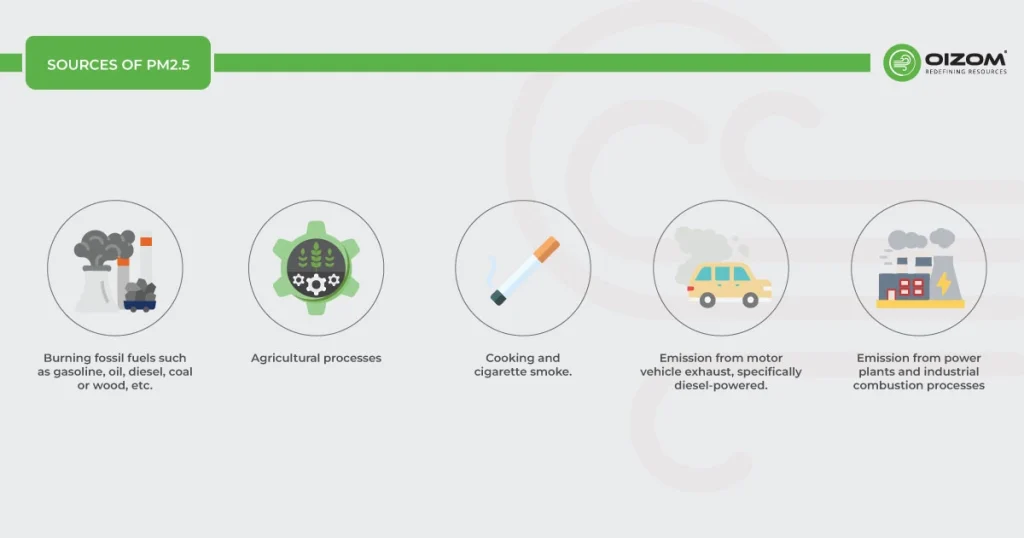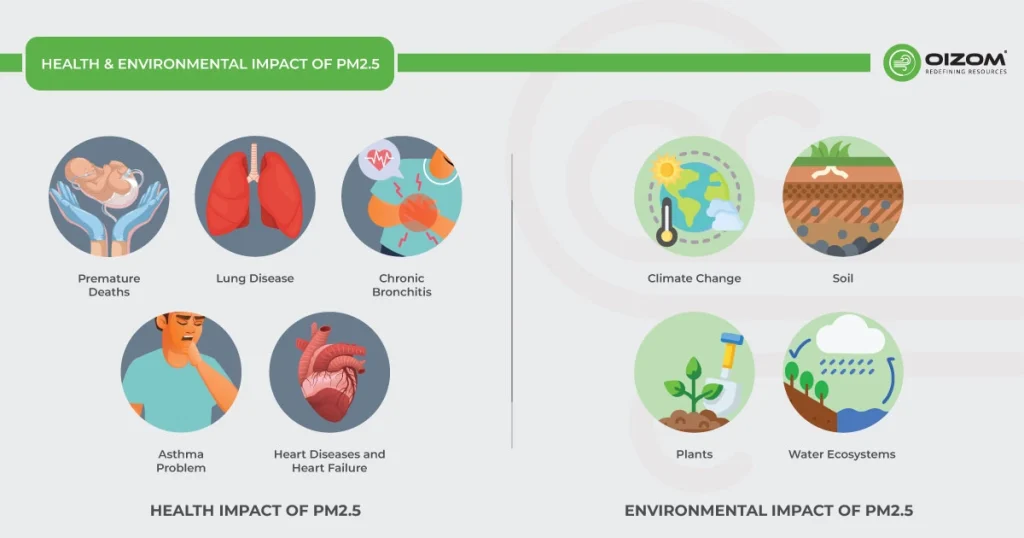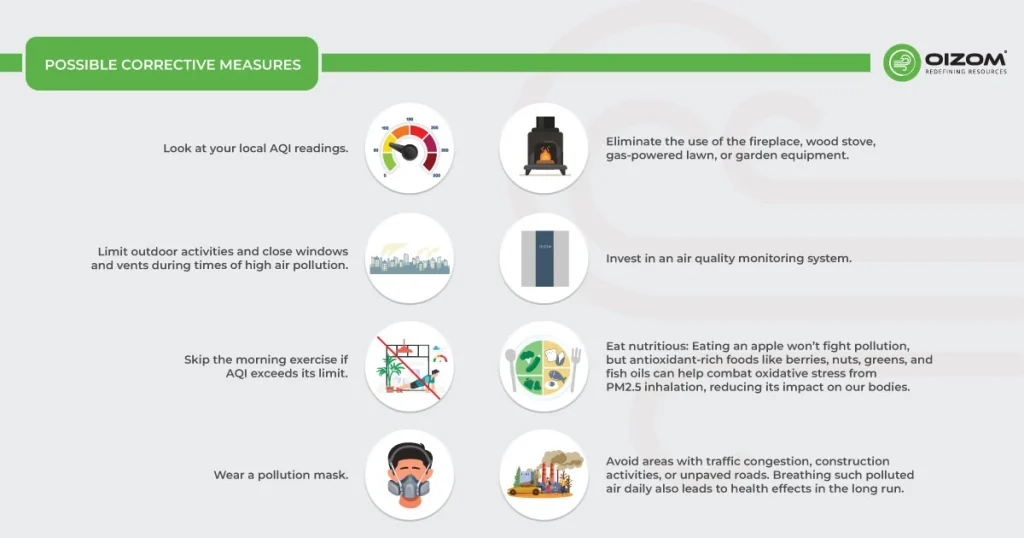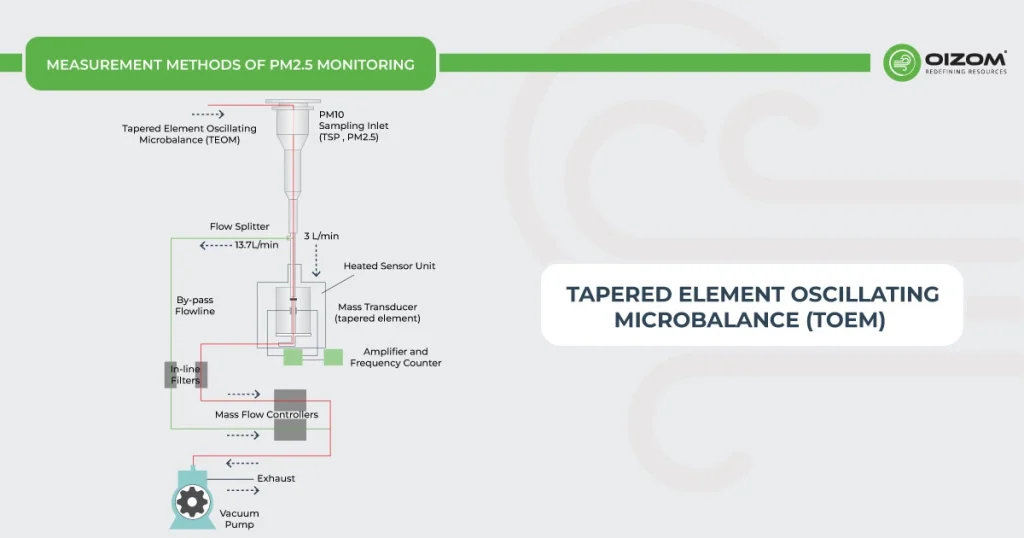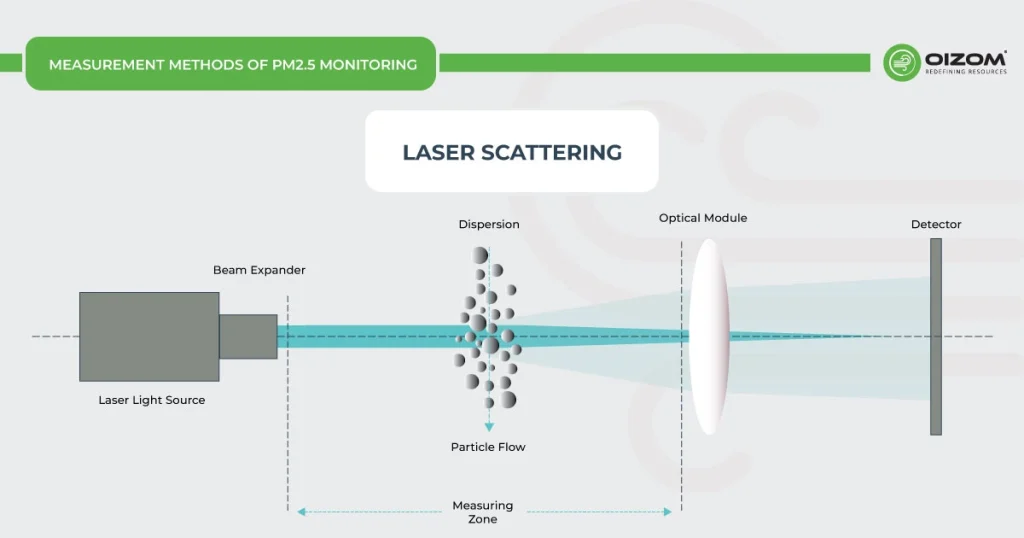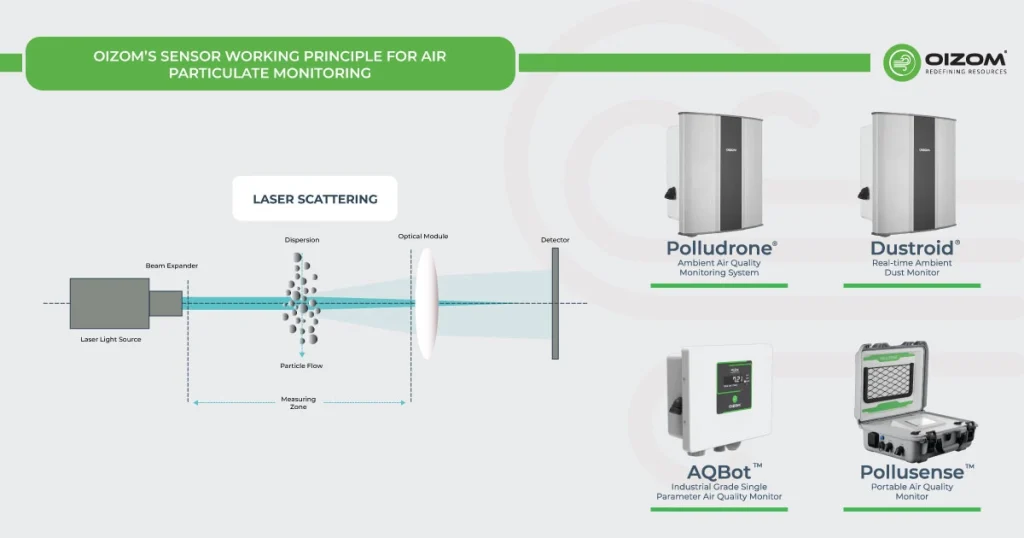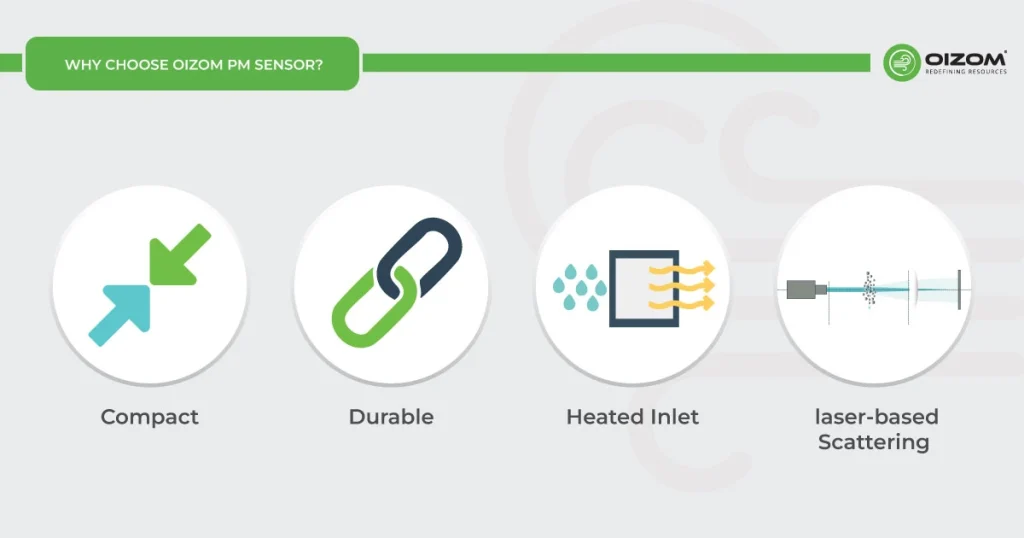1. What is PM2.5 or Respiratory Suspended Particulate Matter (RSPM)?
PM stands for particulate matter (also known as particle pollution), a mixture of solid particles and liquid droplets prevalent in the air. Dust, dirt, soot, and smoke are examples of large particles that can be seen with the naked eye. For air quality regulatory purposes, these atmospheric particles are defined by their diameter.
PM2.5, or particulate matter with a diameter of 2.5 microns, is collectively known as (PM2.5) Respiratory Suspended Particulate Matter (RSPM). It is considered a critical air pollutant and is regulated by government bodies all around the world. These fine particles are more than 100 times thinner than human hair (too small to be detectable by the human eye). They can easily penetrate deep into the lungs and even enter the bloodstream. Particulate matter PM2.5 is one of six criteria air pollutants for which there are national air quality standards to limit their levels in the outdoor air.
PM2.5 in the atmosphere consists of toxic organic compounds and also heavy metals released from various sources. Once released, they stay in the air for a long time i.e. days or weeks and can travel hundreds of miles.
At first glance, particulate matter might seem pretty simple to grasp. It’s just dust and tiny particles floating around in the air, right? There’s no need to dig out those old high school chemistry books for this one! But the reality is particulate matter is a lot more complex than it appears. Its environmental and health impacts are significant, and it’s something we should all be paying closer attention to.
So, what exactly is particulate matter (PM2.5)? Where does it come from? This article covers information on PM2.5, its sources in the ambient air, permissible levels, health and environmental impact, possible corrective measures, the need for PM2.5 monitors, and different methods of PM2.5 monitoring.
2. Sources
When we think about air pollution, we usually picture factories and power plants as the main sources. While they do contribute to particulate matter, there are plenty of other sources out there, too. In fact, particulate matter can come from both primary sources, like emissions, or secondary sources, where particles form through chemical reactions in the air.
Particulate matter PM2.5 is either directly emitted from a source (primary PM) or is formed through the chemical reactions of gases such as oxides of sulfur (SOx), nitrogen oxides (NOx), organic compounds, etc. in the atmosphere (secondary PM).
The natural sources of PM2.5 particulate matter are marine aerosol, soil erosion, volcanic eruptions, and forest fires.
Anthropogenic sources of PM2.5 include:
- Burning fossil fuels such as gasoline, oil, diesel, coal or wood, etc.
- Agricultural processes
- Cooking and cigarette smoke.
- Emission from motor vehicle exhaust, specifically diesel-powered.
- Emission from power plants and industrial combustion processes.
3. Permissible Levels of PM2.5
The breakpoint concentrations describing air quality based on the PM2.5 concentrations for different countries are given below. In India, the daily average PM2.5 levels of up to 60 μg/m3 are considered satisfactory. The Air quality guidelines by the World Health Organization suggest a 24-hr mean of 25 μg/m3.
Table: Breakpoints of PM2.5 (μg/m3)
|
India (24-hr) |
US (24-hr) |
China (24-hr) |
EU (8-hr) |
||||
|
AQI Category |
Break point concentration |
AQI Category |
Break point concentration |
AQI Category |
Break point concentration |
AQI Category |
Break point concentration |
|
Good |
30 |
Good |
35 |
Excellent |
15 |
Very low |
10 |
|
Satisfactory |
60 |
Moderate |
75 |
Good |
35 |
Low |
20 |
|
Moderately polluted |
90 |
Unhealthy for sensitive |
115 |
Lightly Polluted |
65 |
Medium |
30 |
|
Poor |
150 |
Unhealthy |
150 |
Moderately Polluted |
150 |
High |
60 |
|
Very Poor |
250 |
Very Unhealthy |
250 |
Heavily Polluted |
250 |
Very high |
60+ |
|
Severe |
250+ |
Hazardous |
250+ |
Severely Polluted |
250+ |
||
[Source: National Ambient Air Quality Index, CPCB (Oct 2014)]
4. Health & Environmental Impact of PM2.5
Health Impact
Particulate matter consists of microscopic solids or liquid droplets that are small enough to be inhaled and cause major health issues. Some particles smaller than 10 micrometers in diameter can penetrate deep into your lungs and even enter your bloodstream. Particles with a diameter of less than 2.5 micrometers, often known as fine particles, offer the greatest health danger.
Short-term PM2.5 exposures (up to 24 hours) have been linked to premature death, higher hospital admissions for heart or lung disease, acute and chronic bronchitis, asthma attacks, emergency room visits, respiratory symptoms, and restricted activity days. These negative health impacts have been observed mostly in newborns, children, and older adults who have underlying heart or lung disorders. Furthermore, among all the common air pollutants,
Exposure to PM2.5 pollution for a long period (i.e., months or years) can cause permanent respiratory problems such as asthma, chronic bronchitis, and heart disease and cause reduced lung function growth in children. It can also lead to premature death, particularly for people suffering from chronic lung or heart diseases.
Environmental Impact
Particulate matter has been found in numerous scientific studies to reduce visibility while also negatively impacting climate, ecosystems, and materials. PM, primarily PM2.5, affects visibility by altering how light is absorbed and scattered in the atmosphere.
Regarding climate change, certain components of the ambient PM mixture promote global warming (e.g., black carbon). In contrast, others have a cooling effect (e.g., nitrate and sulfate), resulting in ambient PM having both warming and cooling capabilities.
Additionally, the settling of the air-borne particles on plants, soil, and water ecosystems has harmful effects on them. The metal and organic compounds reduce plant growth and yield, while the deposition of PM into water bodies affects its quality and clarity.
5. Possible Corrective Measures
The primary step is PM2.5 monitoring to identify the areas with high particulate levels. You can utilize air quality alerts to protect yourself and others when PM reaches hazardous levels. In addition to this, the following corrective measures can be taken:
- Look at your local AQI readings.
- Limit outdoor activities and close windows and vents during times of high air pollution.
- Skip the morning exercise if AQI exceeds its limit.
- Wear a pollution mask.
- Eliminate the use of the fireplace, wood stove, gas-powered lawn, or garden equipment.
- Invest in an air quality monitoring system.
- Eat nutritious: Eating an apple won’t fight pollution, but antioxidant-rich foods like berries, nuts, greens, and fish oils can help combat oxidative stress from PM2.5 inhalation, reducing its impact on our bodies.
- Avoid areas with traffic congestion, construction activities, or unpaved roads. Breathing such polluted air daily also leads to health effects in the long run.
6. Measurement Methods of PM2.5 Monitoring
Different working principles for particulate matter monitoring in the ambient environment are Gravimetric, TOEM, Beta Attenuation (BAM), and Laser scattering.
High-volume Gravimetric Method – The PM2.5 monitors based on the gravimetric principle take in the ambient air for 24 hours at a constant flow rate through a size-selective inlet that only allows particulate matter with an aerodynamic diameter of 2.5µm or less to pass through. The particulate matter is collected onto a pre-weighed filter conditioned at constant temperature and humidity conditions. After the 24-hour sampling period, the filter is conditioned again under the same temperature-humidity conditions and reweighted. The difference in the weight corresponds to the mass collected on the filter, which, along with the known flow rate, sampling period, and the total volume of the air sampled, is used to calculate the PM2.5 concentration.
Tapered Element Oscillating Microbalance (TOEM) – It is a proprietary system for particulate matter monitoring. The PM2.5 monitor based on TOEM determines the PM2.5 concentration by continuously weighing the particulates deposited on the filter attached to a hollow tapered element that oscillates in an applied electric field. The oscillating frequency decreases with the accumulation of particulates on the filters. Thermal mass flow controllers constantly control and measure the flow rate of the PM2.5 monitor, which, along with the mass concentration, temperature, and other factors, is used to calculate the PM2.5 concentrations continuously.
Beta Attenuation Monitor (BAM) – The PM2.5 monitoring based on the BAM principle measures the particle mass density using beta radiation attenuation. The particulates in the ambient air drawn into the PM2.5 monitor are deposited on a paper-band filter and exposed to beta rays (i.e., electrons with energies in the 0.01 to 0.1 MeV range), which get attenuated as a function of the particulate mass. The beta count reduces with an increase in the PM2.5 mass, which is recorded by the detector and converted to concentration.
Laser Scattering – The PM2.5 monitor, based on the physical principle of light scattering, also known as optical particle counter (OPC), measures dust particles illuminated by laser light at a 90° angle. The light scattered from each particle is collected at approximately 90° by a mirror and detected by a photo-diode. This signal is then fed into a multi-channel size classifier, where a pulse height analyzer is used to classify each pulse proportional to the particle size. The counts in the channel corresponding to PM2.5 are converted to a concentration of PM2.5.
[Source from researchgate.net]
7. Oizom’s Sensor Working Principle for Air Particulate Monitoring
At Oizom, we offer various Particulate Matter (PM) sensors, including PM1, PM2.5, PM10, and PM100, designed for accurate air quality monitoring across various particle sizes.
Our Particulate Matter sensor module is engineered to accurately measure PM1, PM2.5, PM10, and PM100 concentrations in ambient air, providing real-time data on atmospheric particulate matter levels. The sensor’s advanced support electronics ensure compactness and reliability, making it a robust solution for continuous air quality monitoring.
These sensors work on laser scattering technology with a heated inlet to eliminate moisture and ensure accurate air quality data. Integrating a heavy-duty fan and advanced lasers guarantees precise data and durability, making these sensors ideal for outdoor applications requiring real-time air quality insights.
These advanced particulate matter sensor modules are utilized in our outdoor air quality monitoring systems, such as Polludrone, Pollusense, and AQBot. Additionally, these modules are a key component in our specialized ambient dust monitor Dustroid. These versatile sensors are used in a variety of applications, including national air quality monitoring, environmental health impact assessments, construction site monitoring, mining, smart cities, and air quality research projects. By providing real-time particle concentration data, Oizom’s PM sensor modules support a wide array of environmental monitoring needs, ensuring accurate and reliable air quality data for diverse applications.
Our particulate monitoring sensors are calibrated with reference stations, housing Beta Attenuation Monitor, BAM-1020, which significantly enhances the data accuracy and reliability of our sensors, ensuring high-quality air quality monitoring results.
8. Why Choose Oizom PM Sensor?
- Compact: Our sensors are small and easy to install, perfect for use in any space, making them ideal for portable air quality monitoring. The PM2.5, sensors come pre-calibrated and can be quickly replaced in just a few minutes by removing and replacing the old sensor with a new one.
- Durable: The PM sensor has an expected lifespan of 18 months.
- The dust measurement by the laser scattering principle overestimates the PM concentration levels in condensing high humidity conditions. The data accuracy in such conditions is maintained by dehumidification of the air sample using a heated inlet.
- It reduces the relative humidity of the air sample by 30-40%, eliminating its interference in the particulate measurement.
- PM sensors work on laser-based scattering principles and Advanced algorithms.
9. Reasons Why PM2.5 Monitoring is Important:
- PM2.5 is a complex mixture of microscopic solids and aerosols that can easily pass through the nose and throat, penetrate deep into the lungs, and enter the bloodstream, reaching other body organs.
- Particulate matter is emitted into the atmosphere from vehicular exhaust, power plants, and combustion processes such as the burning of fossil fuels, waste, etc. They are also formed in the atmosphere by various chemical reactions of other air pollutants such as NOx and SOx.
- When inhaled, it irritates the eyes, nose, throat, and airways and can penetrate tissues, causing severe diseases like heart attacks, lung cancer, edema, etc., leading to premature death. , etc.
- PM2.5 monitoring is an efficient way to detect high particulate matter concentrations and prevent high-level exposures.
- Real-time air particulate monitoring helps determine air quality and formulate an action plan to control high levels of PM pollution.
FAQs
1. What is PM2.5?
PM2.5 refers to fine particulate matter 2.5 micrometers or smaller, small enough to penetrate the lungs and bloodstream deep.
2. Why is PM2.5 harmful?
PM2.5 can cause serious health issues, including heart and lung diseases, as it can reach deeper into the respiratory system than larger particles.
3.How can we monitor PM2.5?
PM2.5 is monitored using air quality stations, portable sensors, and sometimes satellite data to track levels in different areas.
4. How can PM2.5 levels be reduced?
Reducing PM2.5 involves limiting emissions from vehicles, factories, and burning activities and using air purifiers indoors.
5.How does PM2.5 affect the environment?
PM2.5 contributes to reduced visibility (haze) and can damage ecosystems by affecting air, soil, and water quality, harming plants and wildlife.




